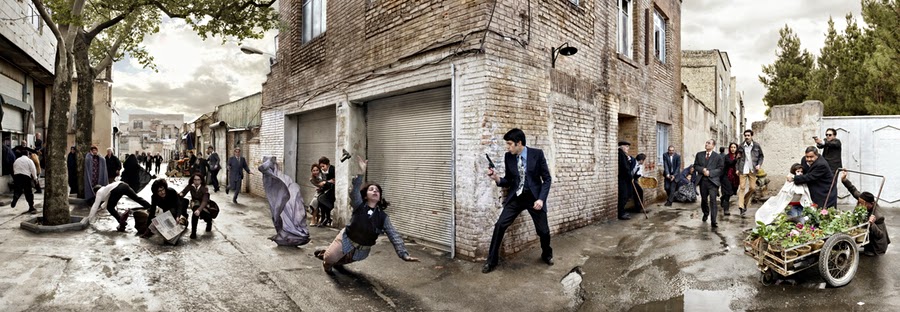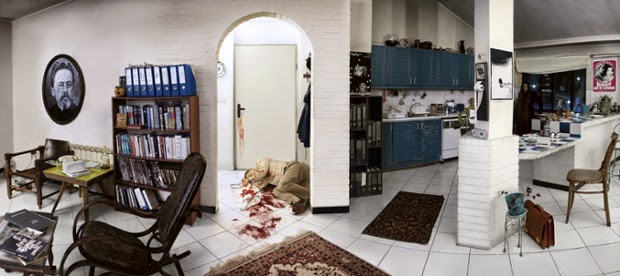Azadeh Akhlaghi: the photographer who stages murders in Iran:
Akhlaghi recreates Iran's most notorious death scenes from the time
before cameraphones, becoming an eyewitness to her nation's past. From
the controversial poet who swerved her car to avoid a school bus and
died in the process, to the mysterious end of Iran's beloved gold-medal
wrestler, here's a selection of images from her astonishing series By An
Eyewitness
Sean O'Hagan meets the Iranian photographer who is restaging infamous murders from her country's history
 |
| A restaging of the shooting of student activist Marzieh Ahmadi Oskuie by secret police (SAVAK). Tehran – 26 April 1974. Photograph: Azadeh Akhlaghi. Courtesy The Guardian. |
In June 2009, a young philosophy student called Neda Agha-Soltan was shot dead by security forces in Tehran during protests against the Iranian elections. The death of Neda, an innocent bystander, was captured by several eyewitnesses on their mobile phones and swiftly posted online – becoming, according to Time magazine, "probably the most widely witnessed death in human history".
In death, Neda was transformed into a global symbol of the Iranian protest movement and an icon for the country's young. She also became the invisible – but powerful – presence in an ambitious conceptual art project by the Iranian photographer Azadeh Akhlaghi. "After the death of Neda," she says, "I started thinking about others who had died in tragic ways, but whose deaths had not been recorded because there was no camera present."
So began four years of research to create By An Eye Witness, a series that meticulously reconstructs 17 deaths from Iranian history using ordinary people and actors. It is one of the highlights of an exhibition of contemporary Iranian photography about to open at London's Somerset House. Entitled Burnt Generation (the name given to Iranians born between 1963 and 1980, who have lived through the social and political fallout of the overthrow of the Shah and the Iran-Iraq war), the show gathers the work of eight young photographers selected by Iranian-born curator Fariba Farshad.
"The work looks at the deep social effects of the long war with Iraq," she says, "as well as the sense of isolation and desolation felt by many young people in Iran. It reflects the contradictions of a society where there are deep tensions between traditional and contemporary culture, between urban and rural tradition, and between the older generation and a young, middle class who are increasingly expressing themselves through art and photography. One of the underlying questions is: how is this nation still united and functioning despite everything?"
To this end, Newsha Tavakolian, born in 1981, has captured, from her bedroom window, the lives of the young middle-class people who share her Tehran apartment building. The results convey a deep sense of isolation and loneliness, suggesting a lost generation who, trapped in a conformist society, have turned inwards. At the other extreme, Babak Kazemi has created Souvenir of Friend and Neighbour Country, in which he photographs spent bullets he has found on his walks as if they were ancient artefacts.
In terms of ambition, though, it is Akhlaghi's work that stands out. Having spent eight years studying film-making in Australia, she returned to work as assistant director to the acclaimed Iranian director Abbas Kiarostami, before switching to conceptual photography. Akhlaghi has had many successful shows in Iran where, according to Martin Barnes, curator of photography at the Victoria and Albert Museum, "some of the most exciting photography in the world is being made today." For one series, Me As Preferred By Others, she approached a cross-section of people – trendy young women in Tehran, traditional elders, Afghan soldiers in Kabul – to choose her an outfit. Each person then posed next to her as she wore their suggestion.
Increasingly, though, Akhlaghi's work has delved into Iran's recent history. "I'm influenced by classical painters like Caravaggio and Van Eyck," she says. "I usually hire a cast and crew and, for each picture, we spend up to a month in pre-production – finding people, setting up the scene, trying out lighting and composition – and then around 20 days actual shooting."
For By An Eye Witness, Akhlaghi reconstructs assassinations, tortures and mysterious killings as well as natural deaths. Alongside the images, she includes extended texts that recount the events using detailed, but often conflicting, eyewitness accounts. She has recreated the deaths of artists and sportsmen, as well as activists, clerics and political figures. Sometimes she uses people who were present at the actual event in her reconstructions.
One unforgettable image looks at the fatal shooting by the military of three students at Tehran University following a protest against a visit from Richard Nixon, then the American vice president, on 7 December 1953. Akhlaghi freeze-frames staff and students as they run in panic down steps while bloodstained bodies lie in corridors surrounded by distraught friends. Iran still remembers the tragedy every year, on Student Day.
When the series was shown in Tehran last year, Akhlaghi wrote an accompanying statement: "It is about the depiction of the moment of dying of people who lived decently and passed bitterly, but there is something sacred about their death, which has been forgotten or stained." The reactions, she says, were extraordinary. "People were hugging me and crying. Some were the relatives of people I had depicted, but most were just ordinary Iranians, young and old, people who do not normally go to art galleries. There is a lot of silence about many of the deaths that have occurred in Iran in recent times. For many, this was a moment when the silence was finally broken."
 |
| Atlantic Hotel, Tehran – Gholamreza Takhti, the Olympic gold-medal wrestler. 7 January 1968. Photograph: Azadeh Akhlaghi. Courtesy The Guardian. |
 |
| Chicago – Sohrab Shahid Saless, famed film director who died in Chicago from chronic liver disease. 1 July 1998. Photograph: Azadeh Akhlaghi. Courtesy The Guardian. |
 |
| Tehran – Mirzadeh Eshghi, political writer killed by two mysterious gunmen at his home. 3 July 1924. Photograph: Azadeh Akhlaghi. Courtesy The Guardian. |
 |
| Qasr Prison, Tehran – Mohammad Farrokhi Yazdi, poet, politician and later political prisoner who died by air injection. 17 October 1939. Photograph: Azadeh Akhlaghi. Courtesy The Guardian. |
Via The Guardian








No comments:
Post a Comment